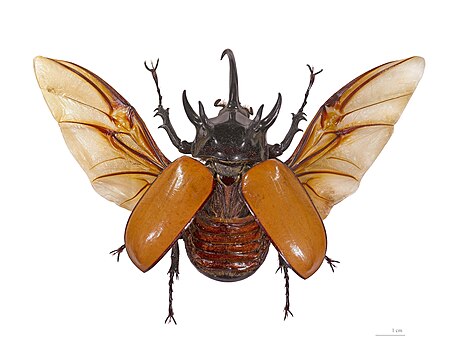Template:Species-2022-10
Species of the month
editFive-horned Beetle
editSome facts about this beetle:
- Length: 50–95 mm.
- Larva diet: Rotten wood.
- Adult diet: Nectar, plant sap and fruit.
- Range: Southeast Asia.
- First described: By the British entomologist Gilbert John Arrow in 1908.
A rhinoceros with five horns? Well, Eupatorus gracilicornis is not quite a rhinoceros but nevertheless it is a fascinating creature. This extravagant beetle is boldly colored with shiny jet-black while the elytra or fore wings are colored yellow or gold. It has four large horns on the pronotum (the foremost thorax segment) and one extra-long cephalic (of the head) horn. The body is covered by a thick exoskeleton and a pair of thick wings lie atop another set of membranous wings underneath, allowing the beetle to fly, although not very efficiently, owing to its large size. The flying season is usually in September, when most of the males usually appear to wait for copulation. Rhinoceros beetles – the Dynastinae – are a subfamily of the scarab beetle family (Scarabaeidae). They are also known as Hercules beetles, unicorn beetles, or horn beetles. There are over 300 described species of these beetles, best known for their bizarre shapes and large size.
